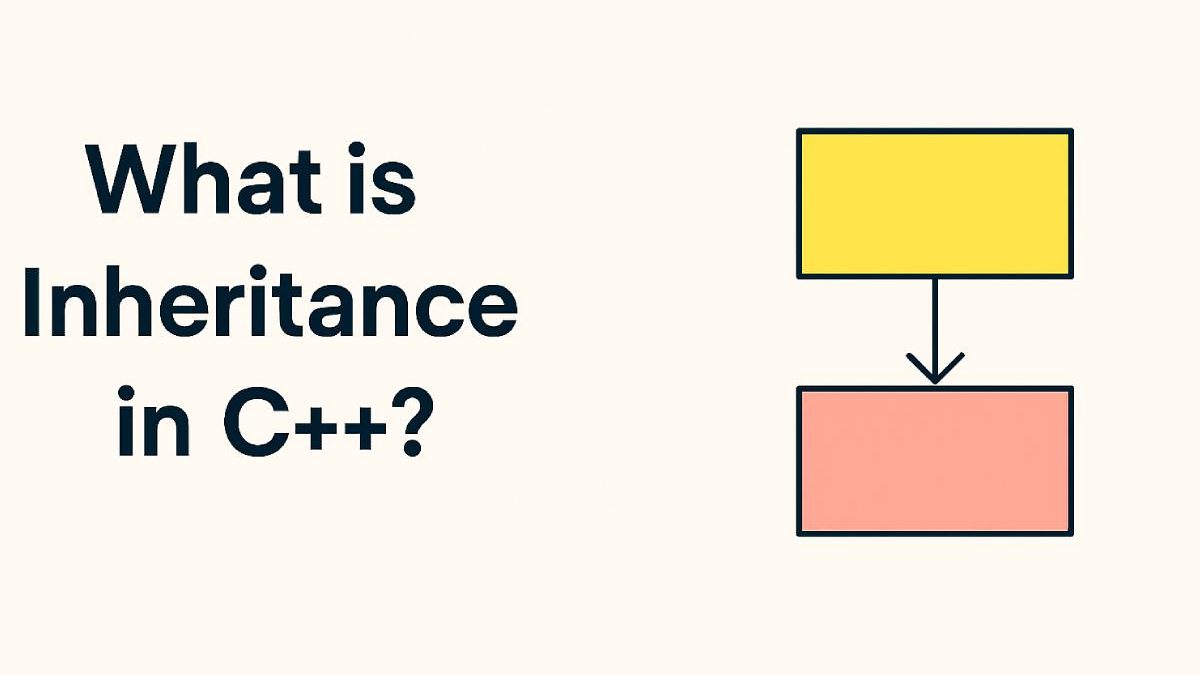What is inheritance in C++? Ugh, don’t even get me started on how confusing this was when I first ran into it. I spent three days trying to figure out why my “Dog” class kept barking at compile-time errors. Turns out, I was doing everything backwards.
Look, inheritance sounds fancy, but it’s really just C++ being lazy in the best possible way. You know how you inherit your mom’s eyes or your dad’s terrible sense of humor? Same concept, but with code. Your new class gets all the good stuff from the parent class, plus whatever new tricks you want to add.
Table of Contents
ToggleThe Lightbulb Moment: When Inheritance Finally Made Sense
I’ll never forget the day inheritance clicked for me. I was building this inventory system for a small retail shop – nothing fancy, just tracking products. I had separate classes for books, electronics, and clothing. Each one had the same basic stuff: price, name, SKU, you know the drill.
After copy-pasting the same 20 lines of code for the fourth time, I thought, “There’s gotta be a better way.” That’s when my senior developer walked by and said, “Ever heard of inheritance?”
Two hours later, I had a base “Product” class handling all the common stuff, and my specific product types just inherited from it. Mind blown. Suddenly, I wasn’t copy-pasting code like some kind of caveman.
C++ Inheritance Types: The Good, The Bad, and The Weird
Public Inheritance: Your Daily Driver
Public inheritance is like borrowing your friend’s car – you get all the functionality, and everyone can see you using it. This is what you’ll use 95% of the time.
class Animal {
public:
void eat() { cout << "nom nom nom"; }
void sleep() { cout << "zzz"; }
};
class Dog : public Animal {
public:
void bark() { cout << "woof!"; }
};My Dog can eat, sleep, AND bark. Perfect.
Protected Inheritance: The Awkward Middle Child
Protected inheritance is like having a family recipe that only family members can use. I’ve used it maybe twice in ten years. Most of the time, if you think you need protected inheritance, you probably want composition instead.
Private Inheritance: The Weird Cousin
Private inheritance is… weird. It’s like saying “I want to use your stuff, but I don’t want anyone to know we’re related.” I’ve honestly never used this in a real project. If I need private inheritance, I usually just use composition and call it a day.
Single vs Multiple Inheritance: One Parent vs Two
Single Inheritance: Keep It Simple, Stupid
The Single inheritance is like having one set of parents. Clean, simple, no weird family dynamics. Your class gets one base class, inherits all its public and protected stuff, and life is good.
I was working on this game engine where I had a “GameObject” base class. Every enemy, player, and power-up inherited from it. Worked like a charm because everything in the game was fundamentally a game object.
Multiple Inheritance: The Family Reunion From Hell
Multiple inheritance lets you inherit from multiple base classes. Sounds great in theory, right? Wrong. It’s like having divorced parents who both show up to your graduation and start arguing about who gets to sit where.
I tried this once with a “SmartPhone” class that inherited from both “Phone” and “Computer.” Both had a “powerOn()” method. Which one should SmartPhone use? The compiler had no idea, I had no idea, and the whole thing turned into a debugging nightmare.
Virtual Inheritance: The Peacekeeper
Virtual inheritance is C++’s way of saying “okay, fine, you can have multiple parents, but let’s not get crazy about it.” It prevents the diamond problem where you end up with multiple copies of the same base class.
class Device {
public:
void powerOn() { cout << "beep"; }
};
class Phone : virtual public Device { };
class Computer : virtual public Device { };
class SmartPhone : public Phone, public Computer { };Now SmartPhone only gets one copy of Device, and everybody’s happy. Well, happier.
The Virtual Function Rabbit Hole
Virtual functions are where inheritance gets really interesting. They let your base class say “I don’t know exactly how to do this, but my child classes will figure it out.”
I was building a drawing program where I had different shapes. Instead of having a giant switch statement checking what type of shape I was dealing with, I made a virtual “draw()” function in the base “Shape” class. Each derived class implemented its own version.
Here’s the magic: I could have an array of Shape pointers, call draw() on each one, and the right version would automatically run. No if-statements, no type checking, just pure polymorphic bliss.
Constructor Chaos: Who Goes First?
Constructors in inheritance are like a line at Starbucks – base class goes first, then derived class. Destructors are the opposite – derived class cleans up first, then base class.
I learned this the hard way when I was managing database connections. My base class opened a connection, derived class did some fancy stuff. If I didn’t handle the destructors right, I’d leak connections everywhere. Production went down. Not fun.
Pro tip: Always make your base class destructor virtual if you’re using polymorphism. Trust me on this one.
Function Overriding: Same Name, Different Game
Function overriding lets derived classes replace base class methods with their own versions. But here’s the catch – the base class method needs to be virtual, or you get function hiding instead of overriding.
I once spent an entire afternoon debugging why my derived class method wasn’t being called. Turns out, I forgot the “virtual” keyword in the base class. Classic mistake that’ll make you question your life choices.
My Biggest Inheritance Disasters
The Great Slicing Incident of 2019
I was assigning derived class objects to base class variables. Everything compiled fine, but all my derived class functionality disappeared. It’s called object slicing, and it’s sneaky as hell.
The Five-Parent Monster
I inherited (pun intended) a codebase where someone thought it was a good idea to have classes inherit from five different base classes. Debugging that thing was like trying to solve a Rubik’s cube blindfolded while riding a unicycle.
The Virtual Destructor Disaster
Forgot to make a base class destructor virtual. Result? Memory leaks everywhere. The application slowly ate more and more RAM until the server crashed. Good times.
When NOT to Use Inheritance
Sometimes inheritance is the wrong tool for the job. If you’re thinking “has-a” instead of “is-a,” use composition.
A Car has an Engine, but it’s not an Engine. A House has a Door, but it’s not a Door. I’ve seen people try to inherit Door from House, and it’s just… wrong. Don’t do it.
Real Talk: Inheritance in the Wild
I’m working on this e-commerce platform right now. We have a base “Order” class that handles common stuff like calculating totals, applying taxes, and tracking status. Then we have “RetailOrder,” “WholesaleOrder,” and “SubscriptionOrder” that inherit from it.
Each order type has its own quirks – wholesale orders get bulk discounts, subscription orders auto-renew, retail orders… well, they’re just normal orders. But they all share the core order functionality.
This approach saved us from duplicating hundreds of lines of code. When we needed to add a new tax calculation method, we changed it in one place, and all order types got the update automatically.
The Modern C++ Twist
These days, C++ has templates, smart pointers, and all sorts of fancy stuff that sometimes makes inheritance less necessary. But inheritance still has its place.
I use inheritance when:
- I have a clear “is-a” relationship
- I need polymorphic behavior
- I’m extending someone else’s code without modifying it
- I’m building a framework where users need to customize behavior
Composition vs Inheritance: The Eternal Debate
Here’s my rule of thumb: if you can express the relationship as “is-a,” use inheritance. If it’s “has-a,” use composition.
A Manager is an Employee (inheritance). A Car has an Engine (composition). A Duck is a Bird (inheritance). A House has a Kitchen (composition).
When in doubt, go with composition. It’s more flexible, easier to test, and won’t make your coworkers hate you.
The Bottom Line on C++ Inheritance
What is inheritance in C++? It’s a tool that can make your code cleaner, more maintainable, and less repetitive. But like any tool, you can hurt yourself with it if you’re not careful.
Start simple. Use single inheritance with clear “is-a” relationships. Learn virtual functions and polymorphism. Avoid multiple inheritance until you really, really need it (spoiler: you probably don’t).
Most importantly, don’t overthink it. Inheritance is just one way to organize your code. If it’s making your life harder instead of easier, you’re probably doing it wrong.
After fifteen years of writing C++, I’ve learned that the best inheritance hierarchy is usually the simplest one that solves your problem. Don’t build a cathedral when you need a toolshed.
Related Post: What is Normalization in DBMS: The Complete Guide
Shashi Teja
Related posts
Hot Topics
Youth Sports Camps Build Character
We do not all become professional sports players; however, every child can benefit from youth sport programs. There is a…
Best DMARC Lookup Tools: Instantly Check & Verify Your DMARC Records
Choosing the best DMARC lookup tools is essential for any organization that wants to secure its email domain and prevent…



